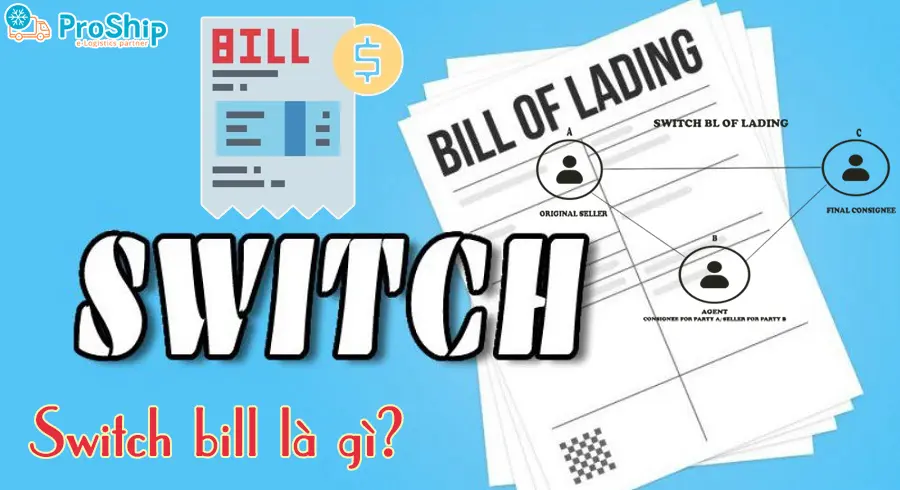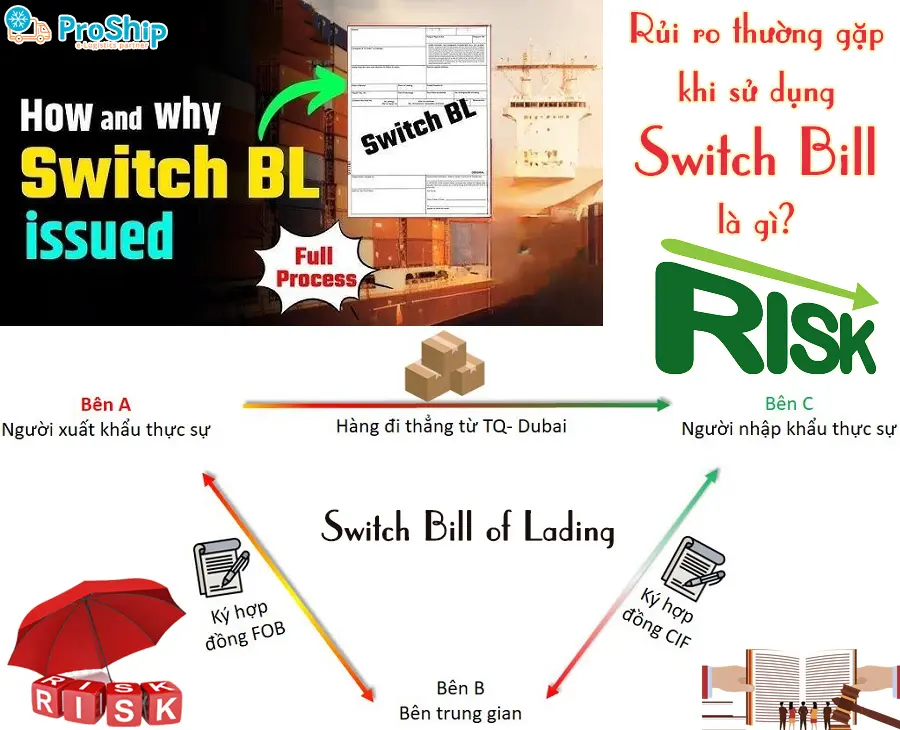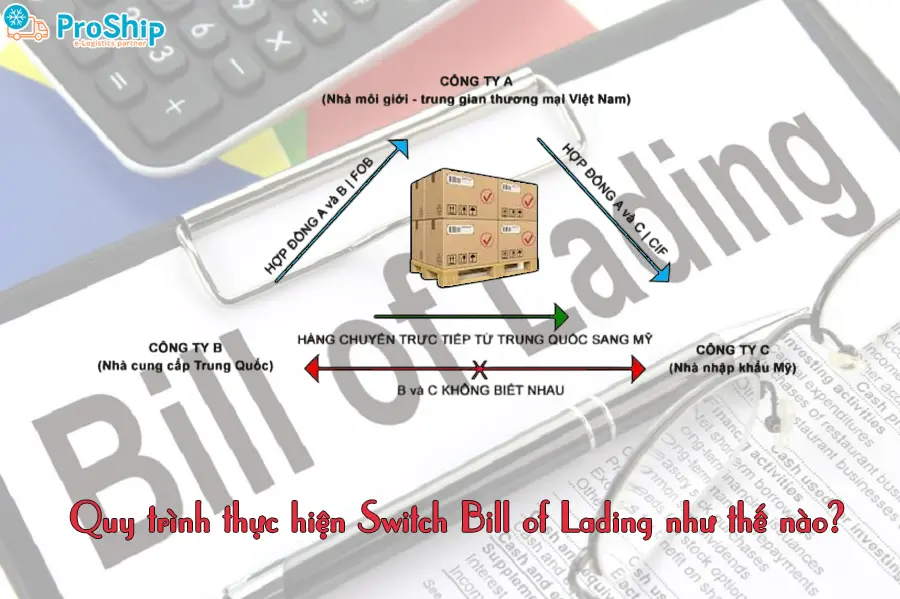x Bạn đang tham gia vào hoạt động mua bán một lô hàng gồm ba bên, bốn bên,…và cần tìm hiểu Switch Bill thực chất là gì? Đóng vai trò quan trọng ra sao trong xuất, nhập khẩu?
x Bạn muốn biết việc sử dụng Switch Bill có dễ gặp phải rủi ro gì hay không? Bên nào chịu trách nhiệm phê duyệt Switch Bill?
x Bạn chưa nắm rõ quy trình thực hiện Switch Bill diễn ra thế nào?
Proship.vn chúng tôi sẽ thông tin chi tiết về Switch bill là gì, Switch bill có vai trò gì trong hoạt động xuất nhập khẩu, sử dụng Switch bill có gặp phải rủi ro gì không, quy trình các bước thực hiện Switch bill như thế nào,…ngay sau đây.
Switch Bill là gì, có vai trò gì? Ai sẽ phê duyệt Switch bill?
Bạn thắc mắc Switch bill nghĩa là gì và đơn vị nào sẽ phê duyệt switch bill? Cùng Proship tìm đọc nội dung sau để có câu trả lời:
Switch bill là gì?
Switch bill là gì? Switch Bill hay “Switch Bill Of Lading” sử dụng để thay thế cho vận đơn ban đầu. Chứng từ này áp dụng trong mua bán hàng hóa, có sự tham gia của bên trung gian. Mục đích của Switch Bill là thay đổi thông tin của Nhà sản xuất.

Vai trò của Switch bill
Switch Bill có vai trò quan trọng trong các giao dịch thương mại quốc tế, đặc biệt khi có sự tham gia của các bên trung gian, cụ thể, Switch bill giúp:
- Bảo mật thông tin các bên:
Khi sử dụng Switch Bill, thông tin chi tiết của các công ty nhập khẩu và xuất khẩu sẽ không được tiết lộ. Nhờ vậy, hai bên không thể biết được danh tính thực sự của nhau, giúp đảm bảo quyền lợi của bên trung gian và ngăn chặn các giao dịch mua bán trực tiếp mà không thông qua trung gian.
- Tiết kiệm chi phí vận chuyển:
Switch Bill cho phép hàng hóa được vận chuyển thẳng từ nơi sản xuất đến nơi nhập khẩu mà không cần qua kho bãi của bên trung gian. Điều này giúp giảm thiểu chi phí vận chuyển và thời gian giao hàng.
- Tăng cường tính linh hoạt trong giao dịch:
Switch Bill giúp các bên dễ dàng thay đổi thông tin trên vận đơn, chẳng hạn như nhà sản xuất hoặc người gửi hàng, phù hợp với yêu cầu của từng giao dịch mà không ảnh hưởng đến quá trình vận chuyển.
Ai chịu trách nhiệm phê duyệt Switch bill?
Hãng tàu hoặc Forwarder là đơn vị được ủy quyền phê duyệt Switch bill. Các bên này có thẩm quyền kiểm tra sự khác nhau giữa hai vận đơn (vận đơn ban đầu và vận đơn được yêu cầu switch) và ký nhận.
Các điều kiện Incoterm nên dùng trong Switch Bill và lưu ý cần biết
Cùng Proship tiếp tục tìm hiểu các điều kiện Incoterm nên dùng trong switch bill là gì và cần lưu ý gì khi sử dụng sau đây:
Điều kiện Incoterm nên dùng trong Switch Bill
Khi đã xác định được Switch Bill, bên trung gian cần phải xác định rõ những điều kiện giao hàng và sử dụng hình thức thanh toán phù hợp, lựa chọn đúng các đơn vị cung cấp Dịch vụ vận chuyển uy tín.
Với các Công ty trung gian sẽ luôn giành quyền book tàu. Nhưng để có thể làm được điều này cần có 2 hợp đồng được ký đó là giữa A và B, giữa A và C. Lúc này, sẽ có một số điều kiện với nhóm này là:
- Bên A ký hợp đồng với bên B, bên A sẽ có vai trò là người nhập khẩu nên sử dụng điều kiện giao hàng để giành được quyền book tàu. Phương thức thanh toán được sử dụng đó là thanh toán L/C.
- Bên A sẽ ký hợp đồng xuất nhập khẩu cho bên C. Lúc này, bên A sẽ chuyển thành người xuất khẩu hàng hóa để giành quyền book tàu. Bên A sẽ ký hợp đồng theo điều kiện của bên C và áp dụng phương thức thức đó là TT.
- Sau khi bên A đã ký hợp đồng với các bên sẽ cần một Đơn vị vận tải hỗ trợ cho bên A thực hiện Switch bill.
Lưu ý khi sử dụng Switch Bill of Lading
Khi sử dụng Switch Bill of Lading để chuyển đổi vận đơn ban đầu cần lưu ý:
- Thông tin được thay đổi trong bill: Shipper, consignee, cargo description;
- Thông tin không được thay đổi gồm: cảng đi, cảng dỡ hàng, số lượng hàng và kiện hàng;
- Lưu ý ngày phát hành vận đơn ban đầu và vận đơn switch cần giống nhau.
Rủi ro thường gặp khi sử dụng Switch Bill
Những rủi ro thường gặp phải khi sử dụng switch bill là gì? Đó có thể là:
Rủi ro về nguy cơ gian lận
Nếu một lô hàng có nhiều hơn một bộ vận đơn cùng lưu hành, có thể dẫn đến tình trạng có nhiều người nhận hàng cùng giữ bản chính hợp lệ tại cảng đến. Điều này có thể gây ra tranh chấp về quyền sở hữu hàng hóa. Các hậu quả pháp lý phát sinh từ đó có thể sẽ rất nghiêm trọng cho người vận chuyển và người nhận hàng cuối cùng.

Rủi ro về mặt pháp lý
Việc sử dụng Switch Bill có thể gây ra các mâu thuẫn vô ý, thậm chí vi phạm luật pháp ở các quốc gia khác nhau. Vì vậy, khi giao dịch thương mại cần nắm vững luật pháp liên quan trong các quốc gia khác nhau, đặc biệt khi Switch Bill được phát hành ở một khu vực khác so với B/L gốc ban đầu.
Mất quyền bảo vệ và bồi thường bảo hiểm
Sự bất hợp pháp trong việc sử dụng Switch Bill có thể dẫn đến mất quyền bảo vệ và bảo hiểm bồi thường. Ví dụ, nếu mô tả hàng hóa trong Switch Bill được phát hiện là không chính xác, việc bồi thường có thể bị ảnh hưởng, thậm chí bị đơn vị bảo hiểm từ chối.
Quy trình thực hiện Switch Bill of Lading
Quy trình thực hiện Switch Bill of Lading như sau:
Vận đơn 1 (vận đơn ảo)
Sau khi ký hợp đồng mua bán với cả A (bên xuất khẩu – bên bán) và C (bên nhập khẩu – bên mua), người trung gian B yêu cầu người bán A ở Trung Quốc giao hàng và chỉ định Forwarder phát hành B/L như sau:
- Shipper: Người bán A;
- Consignee: Người trung gian B (nếu thanh toán T/T) hoặc Ngân hàng phát hành L/C cho B (nếu thanh toán L/C và nội dung L/C cần ghi chú chấp nhận House B/L);
- Cảng bốc hàng: Trung Quốc;
- Cảng dỡ hàng: Việt Nam.

Vận đơn 2 (được Switch từ vận đơn 1)
Sau khi vận đơn 1 được phát hành và người trung gian B đã nhận được hàng từ bên A tại cảng Trung Quốc, bên B tiến hành thanh toán cho bên A và nhận được đầy đủ bộ chứng từ giao hàng.
Lúc này, lô hàng hoàn toàn thuộc quyền sở hữu của bên B và yêu cầu Forwarder Switch B/L bằng cách hủy B/L 1 (bill ảo), tiếp theo là phát hành B/L mới (bill thật) với thông tin:
- Shipper: Người trung gian B;
- Consignee: Người mua C;
- Cảng bốc hàng: Trung Quốc;
- Cảng dỡ hàng: Mỹ;
- Mô tả hàng không thay đổi (có thể thay đổi nếu cần).
Khi đã được cấp Switch B/L theo yêu cầu, bên B tập hợp bộ chứng từ giao hàng mới và gửi cho người mua C để họn nhận hàng tại cảng đến ở Mỹ.
Hi vọng bài chia sẻ kiến thức trên đã giúp bạn hiểu rõ Switch bill là gì, đóng vai trò quan trọng ra sao trong xuất nhập khẩu cũng như quy trình chuyển đổi vận đơn thế nào. Proship Logistics tự hào là một trong những đơn vị chuyên cung cấp Dịch vụ KBHQ, Dịch vụ vận chuyển hàng đa phương thức và tư vấn cho doanh nghiệp các giấy tờ, loại chứng từ, vận đơn đường sắt/bộ/biển/hàng không,…liên hệ ngay 0909 344 247 để được hỗ trợ dịch vụ bạn quan tâm.
